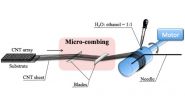(Press-News.org) Out loud, someone says, "The man is catching a fish." The same person then takes pen to paper and writes, "The men is catches a fish."
Although the human ability to write evolved from our ability to speak, writing and talking are now such independent systems in the brain that someone who can't write a grammatically correct sentence may be able say it aloud flawlessly, discovered a team led by Johns Hopkins University cognitive scientist Brenda Rapp.
In a paper published this week in the journal Psychological Science, Rapp's team found it's possible to damage the speaking part of the brain but leave the writing part unaffected -- and vice versa -- even when dealing with morphemes, the tiniest meaningful components of the language system including suffixes like "er," "ing" and "ed."
"Actually seeing people say one thing and -- at the same time -- write another is startling and surprising. We don't expect that we would produce different words in speech and writing," said Rapp, a professor in the Department of Cognitive Science in the university's Krieger School of Arts and Sciences. "It's as though there were two quasi-independent language systems in the brain."
The team wanted to understand how the brain organizes knowledge of written language -- reading and spelling -- since that there is a genetic blueprint for spoken language but not written. More specifically, they wanted to know if written language was dependent on spoken language in literate adults. If it was, then one would expect to see similar errors in speech and writing. If it wasn't, one might see that people don't necessarily write what they say.
The team, which included Simon Fischer-Baum of Rice University and Michele Miozzo of Columbia University, both cognitive scientists, studied five stroke victims with aphasia, or difficulty communicating. Four of them had difficulties writing sentences with the proper suffixes, but had few problems speaking the same sentences. The last individual had the opposite problem -- trouble with speaking but unaffected writing.
The researchers showed the individuals pictures and asked them to describe the action. One person would say, "The boy is walking," but write, "the boy is walked." Or another would say, "Dave is eating an apple" and then write, "Dave is eats an apple."
The findings reveal that writing and speaking are supported by different parts of the brain -- and not just in terms of motor control in the hand and mouth, but in the high-level aspects of word construction.
"We found that the brain is not just a 'dumb' machine that knows about letters and their order, but that it is 'smart' and sophisticated and knows about word parts and how they fit together," Rapp said. "When you damage the brain, you might damage certain morphemes but not others in writing but not speaking, or vice versa."
This understanding of how the adult brain differentiates word parts could help educators as they teach children to read and write, Rapp said. It could lead to better therapies for those suffering aphasia.
INFORMATION:
Parts of this research were funded by the National Institute on Deafness and Other Communication Disorders through Grant DC012283.
Related links:
Brenda Rapp: http://cogsci.jhu.edu/people/rapp.html
Journal article: http://pss.sagepub.com/content/early/2015/04/28/0956797615573520.full
Environmental factors similar to those affecting the present day Great Barrier Reef have been linked to a major slowdown in its growth eight thousand years ago, research led by the University of Sydney, Australia shows.
"Poor water quality, increased sediments and nutrients - conditions increasingly being faced by the modern day reef - caused a delay in the Reef's growth of between seven hundred and two thousand years duration," said Belinda Dechnik, from the University of Sydney's School of Geosciences and lead author of an article published in Marine Geology in May. ...
Why does a species not adapt to an ever-wider range of conditions, gradually expanding its geographical range? In their paper published on May 5 in PNAS (Proceedings of the National Academy of Sciences), Jitka Polechova and Nick Barton at the Institute of Science and Technology Austria (IST Austria) seek to answer this question, which lies at the interface between ecology and evolution. The theory presented by Polechova and Barton suggests that any natural population is liable to form sharp margins.
J.B.S. Haldane, one of the founders of population genetics, studied ...
In cooperation with a Swiss research team, geographers of Ludwig-Maximilians-Universitaet (LMU) in Munich have developed a novel measuring system relying on two different physical methods that promises to enhance forecasting of avalanches and spring floods. The method combines GPS and radar to measure snow properties also on the slopes.
Accurate forecasting of avalanches, and the risk of flooding in Alpine catchment areas during the spring thaw, primarily requires time-resolved data on snow volumes and the levels of liquid water in the snow cover. A research group led ...
Researchers from North Carolina State University and China's Suzhou Institute of Nano-Science and Nano-Biotics have developed an inexpensive technique called "microcombing" to align carbon nanotubes (CNTs), which can be used to create large, pure CNT films that are stronger than any previous such films. The technique also improves the electrical conductivity that makes these films attractive for use in electronic and aerospace applications.
"It's a simple process and can create a lightweight CNT film, or 'bucky paper,' that is a meter wide and twice as strong as previous ...
Alzheimer's disease (AD) is a neurodegenerative condition that strikes at the heart of what makes us human: the ability to think, to feel, to remember and to communicate with those around us. The tragedy is compounded by the fact that there is currently no cure, no treatment, and no diagnostic method capable of identifying Alzheimer's at its early stages.
A ground-breaking study has now, for the first time anywhere, characterized early-stage changes that occur inside individual, Alzheimer's-affected cells in the intact brain. Remarkably, the study indicates that even ...
How many websites have you clicked on recently that haven't converted their format to mobile, frustrating your efforts to get the information you need in an effective and timely way?
Now researchers from Northwestern University have unearthed some provocative facts on how consumers utilize their mobile devices to buy groceries. With the global market for smartphones predicted to reach two billion by 2016, their findings should convince retailers planning marketing strategies and advertising campaigns that they need to pay attention to mobile.
In "On the Go: How Mobile ...
PITTSBURGH (May 5, 2015) ... For decades, robots have advanced the efficiency of human activity. Typically, however, robots are formed from bulky, stiff materials and require connections to external power sources; these features limit their dexterity and mobility. But what if a new material would allow for development of a "soft robot" that could reconfigure its own shape and move using its own internally generated power?
By developing a new computational model, researchers at the University of Pittsburgh's Swanson School of Engineering have designed a synthetic polymer ...
Treating gum disease reduced symptoms of prostate inflammation, called prostatitis, report researchers from Case Western Reserve University School of Dental Medicine and the Departments of Urology and Pathology at University Hospitals Case Medical Center.
Previous studies have found a link between gum disease and prostatitis, a disease that inflames the gland that produces semen. Inflammation can make urination difficult.
"This study shows that if we treat the gum disease, it can improve the symptoms of prostatitis and the quality of life for those who have the disease," ...
Although the use of cannabis as a medical drug is currently booming (Dtsch Arztebl Int 2012; 109: 495-501), we should not forget that leisure time consumption--for example, smoking weed--can cause acute and chronic harms. These include panic attacks, impaired coordination of movement, and nausea, as Eva Hoch and colleagues show in a topical review article in Deutsches Ärzteblatt International (Dtsch Arztebl Int 2015; 112: 271-8). The symptoms depend on a patient's age, the amount of the drug consumed, and the frequency of drug use. It also matters in which form the ...
(Winston-Salem, N.C. - May 5, 2015) - Researchers from Wake Forest University and the University of Utah are the first to successfully fabricate halide organic-inorganic hybrid perovskite field-effect transistors and measure their electrical characteristics at room temperature.
"We designed the structure of these field-effect transistors that allowed us to achieve electrostatic gating of these materials and determine directly their electrical properties," said lead author, Oana Jurchescu, an assistant professor of physics at Wake Forest. "Then we fabricated these transistors ...

